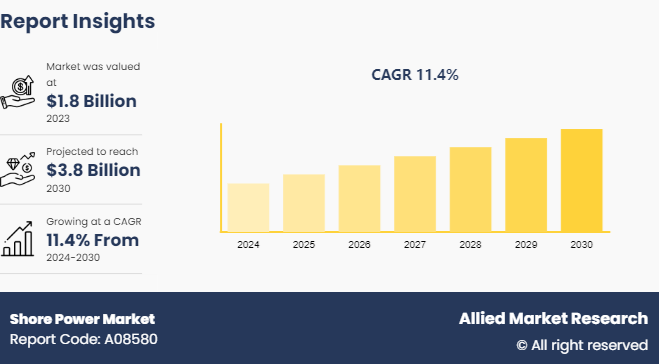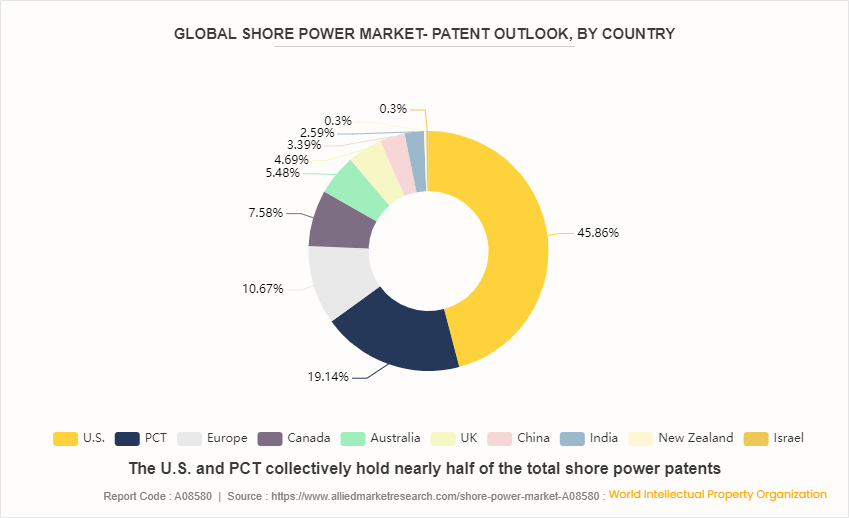Shore Power Market Research, 2030
The global shore power market size was valued at $1.8 billion in 2023, and is projected to reach $3.8 billion by 2030, growing at a CAGR of 11.4% from 2024 to 2030.

Market Introduction and Definition
Shore power, also known as cold ironing or alternative maritime power (AMP) , refers to the practice of connecting ships to an onshore electricity supply while they are docked at port, allowing them to shut down their onboard generators. This system reduces the need for ships to burn fuel to generate power for essential functions, thereby minimizing emissions of pollutants and greenhouse gases. Shore power is an important environmental measure, particularly in port cities, as it helps reduce air pollution and supports efforts to make the maritime industry more sustainable.
Key Takeaways
- The shore power market share covers 20 countries. The research includes a segment analysis of each country in terms of value for the projected period.
- More than 1,500 product literatures, industry releases, annual reports, and other such documents of major shore power industry participants along with authentic industry journals, trade associations' releases, and government websites have been reviewed for generating high-value industry insights.
- The study integrated high-quality data, professional opinions and analysis, and critical independent perspectives. The research approach is intended to provide a balanced view of global markets and to assist stakeholders in making educated decisions to achieve their most ambitious growth objectives.
Key Market Dynamics
As the maritime industry shifts towards greener technologies, electric and hybrid vessels have become a focal point due to their potential to reduce greenhouse gas emissions and improve energy efficiency. These vessels rely heavily on electrical power, especially when docked at ports, which traditionally use their onboard diesel generators to maintain essential functions such as lighting, heating, cooling, and communications. In addition, as electric and hybrid vessels become more prevalent, ports worldwide are investing in the necessary shore power systems to accommodate these vessels. This infrastructure supports the environmental goals of the maritime industry and aligns with the broader push towards decarbonization and cleaner energy in global transportation networks. All these factors are expected to drive the shore power market growth.
However, high initial installation costs are a significant barrier to the widespread adoption of shore power systems, impeding the growth of the market. Setting up shore power infrastructure involves substantial capital expenditure, both for ports and for vessels that need to be equipped with the necessary technology to connect to shore power. For ports, this includes the cost of upgrading electrical grids, installing transformers, cabling, and power management systems, and ensuring the infrastructure handle the power demands of multiple vessels simultaneously. All these factors are expected to hamper the shore power market growth.
Technological advancements are in power conversion technology, which allows shore power systems to accommodate different voltage and frequency requirements of vessels from various regions. This flexibility is crucial for international ports that service a wide range of ships with differing electrical standards. With advanced power conversion systems, ports now provide a seamless connection for vessels, regardless of their origin, thereby enhancing the appeal and feasibility of shore power. All these factors are anticipated to offer new growth opportunities for the shore power market forecast.
Global Shore Power Market- Patent Outlook, by Country
The U.S. and PCT collectively hold nearly half of the total shore power patents that indicate strong innovation and investment in this technology in both countries. This indicates strong competition and a significant focus on shore power R&D in these leading economies. U.S. has the highest patent filed which accounts for 46% of the total global patents related to the shore power market. India and China, although holding smaller percentages of shore power patents individually, collectively contribute to the overall Asian dominance in shore power innovation.

Innovation In Shore Power Market
- Automated Connection Systems: Robotic arms or automated systems are being developed to facilitate faster and more efficient connection of ships to shore power facilities.
- High-Power Shore Connection Systems: Innovations in high-power connections are enabling larger vessels, such as cruise ships and container ships, to utilize shore power.
- Mobile Shore Power Units: Portable shore power units are being developed to provide flexibility in supplying power to ships at berths without fixed infrastructure.
- Integration with Smart Grids: Smart grid technologies can optimize the integration of shore power into the local electricity grid, ensuring grid stability and efficient energy management.
Market Segmentation
The shore power market is segmented into power output, component, connection, and region. By power output, the market is classified into <100kW, 100 – 500kW, 500-1000kW, >1000KW. By component, the market is divided into transformer, control panel, frequency converter, connectors and cables, and others. By connection, the market is categorized into passengers vessels, offshore supply vessel, fishing vessels, containers vessels, oil tankers, and others. Region-wise the market is analyzed across North America, Europe, Asia-Pacific, and LAMEA.
Regional Market Outlook
European governments and the EU provide substantial financial support and incentives for the installation of shore power infrastructure. This includes grants, subsidies, and low-interest loans designed to offset the high initial costs of setting up shore power systems. Such financial assistance makes the investment more attractive for ports and shipping companies, encouraging rapid adoption and expansion of shore power capabilities.
Competitive Landscape
The major players operating in the shore power market include Schneider Electric, Siemens AG, ABB Ltd, Wärtsilä Corporation, Prysmian Group, Eaton Corporation, ESL Power Systems, Inc., Terasaki Electric Co., Ltd, Cavotec SA, Manta Marine Technologies and others.
Recent Key Strategies and Developments
- In September 2023, Wärtsilä Corporation is set to supply an integrated hybrid propulsion system for two pioneering hybrid RoRo vessels currently under construction at the China Merchants Jinling shipyard (Weihai) Co., Ltd for Swedish shipping company Stena RoRo. These vessels will be the world's first to operate on methanol fuel, combined with hybrid propulsion technology. Once completed, they will serve in the Stena Line Irish Sea system. This initiative aligns with Stena RoRo's commitment to sustainable operations, integrating new eco-friendly fuels and electrification to reduce environmental impact.
- In April 2024, Cavotec SA announced a significant order for shore power solutions, valued at approximately $5 million, from a major global shipping company. The deal includes a large number of Cavotec's PowerFit shore power units, designed to allow vessels to seamlessly connect to shore power while docked.
- In April 2024, Manta Marine Technologies successfully installed and commissioned onboard shore power systems for three Finnlines vessels includes Finnlady, the Finnmaid, and the Finnstar. These installations reinforce Manta Marine Technologies' standing as a leading provider of turnkey shore power solutions, which are expected to gain increased adoption as the maritime industry shifts towards a low and zero-carbon future.
Industry Trends
- Advancements in technology are making ship operation and performance monitoring increasingly sophisticated. Future ships will be equipped with a comprehensive network of sensors capable of measuring every aspect of their operations, from detecting faults to identifying areas requiring maintenance or repair. Coupled with enhanced ship-to-shore communications, this will enable land-based fleet managers to oversee and control most aspects of a ship’s operation remotely, transforming the way maritime operations are managed.
- The shipping industry is exploring renewable energy to power the fleets of the future. Some of this technology is already being trialled and tested. The Turanor Planet Solar is a catamaran powered by 29, 000 solar cells which has successfully circumnavigated the globe. However, the likeliest application for this technology in commercial shipping will be systems that reduce fuel consumption by supplementing the existing power supply with on-board wind turbines or solar panels.
- Improvements in ship technology, structure and materials will lead to even bigger megaships, particularly within the container shipping industry. Completed in March this year, the MOL Triumph is the world’s largest container ship. It measures 400m long (for comparison, The Shard building in London is 310m tall) . This giant ship will carry up to 20, 150 TEU containers. Manufacturers will seek to take advantage of the lower transport costs that these vessels can provide by gearing their production to make the most efficient use of this container space.
- There is growing interest in the potential of LNG as a fuel for commercial shipping. Those who support LNG believe it can help operators to meet their targets for reduced emissions, while also being competitive on price. CO2 emissions can be reduced by up to 25% when compared with diesel engines. While conventional oil-based fuels will continue to dominate in the near future, there is likely to be increased adoption of LNG for specialist vessels, which gives an opportunity for the technology to be proved and developed on a larger scale
Key Sources Referred
- Invest India
- International Renewable Energy Agency (IREA)
- International Energy Agency (IEA)
- India Brand Equity Foundation (IBEF)
- Power Sources Manufacturers Association
- Energy Star
- European Power Supplies Manufacturers' Association
- Indian Electrical & Electronics Manufacturers'? Association
Key Benefits For Stakeholders
- This report provides a quantitative analysis of the market segments, current trends, estimations, and dynamics of the shore power market analysis from 2024 to 2030 to identify the prevailing shore power market opportunities.
- The market research is offered along with information related to key drivers, restraints, and opportunities.
- Porter's five forces analysis highlights the potency of buyers and suppliers to enable stakeholders make profit-oriented business decisions and strengthen their supplier-buyer network.
- In-depth analysis of the shore power market segmentation assists to determine the prevailing market opportunities.
- Major countries in each region are mapped according to their revenue contribution to the global market.
- Market player positioning facilitates benchmarking and provides a clear understanding of the present position of the market players.
- The report includes the analysis of the regional as well as global shore power market trends, key players, market segments, application areas, and market growth strategies.
Shore Power Market Report Highlights
| Aspects | Details |
| Market Size By 2030 | USD 3.8 Billion |
| Growth Rate | CAGR of 11.4% |
| Forecast period | 2024 - 2030 |
| Report Pages | 240 |
| By Power Output |
|
| By Component |
|
| By Connection |
|
| By Region |
|
| Key Market Players | Terasaki Electric Co., Ltd, ESL Power Systems, Inc, ABB Ltd, Wärtsilä Corporation, Siemens AG, Schneider Electric, Cavotec SA, Eaton Corporation, Prysmian Group, Manta Marine Technologies |
Increasing adoption of electric and hybrid marine vessels. Advancements in shore power technology are the upcoming trends of Shore Power Market in the world.
Passengers vessels is the leading application of Shore Power Market
Europe is the largest regional market for Shore Power
$3.8 billion is the estimated industry size of Shore Power by 2030.
Schneider Electric, Siemens AG, ABB Ltd, Wärtsilä Corporation, Prysmian Group, Eaton Corporation, ESL Power Systems, Inc., Terasaki Electric Co., Ltd, Cavotec SA, Manta Marine Technologies are the top companies to hold the market share in Shore Power.
Loading Table Of Content...



